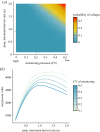Avoiding critical thresholds through effective monitoring
- PMID: 35703054
- PMCID: PMC9198780
- DOI: 10.1098/rspb.2022.0526
Avoiding critical thresholds through effective monitoring
Abstract
A major challenge in sustainability science is identifying targets that maximize ecosystem benefits to humanity while minimizing the risk of crossing critical system thresholds. One critical threshold is the biomass at which populations become so depleted that their population growth rates become negative-depensation. Here, we evaluate how the value of monitoring information increases as a natural resource spends more time near the critical threshold. This benefit emerges because higher monitoring precision promotes higher yield and a greater capacity to recover from overharvest. We show that precautionary buffers that trigger increased monitoring precision as resource levels decline may offer a way to minimize monitoring costs and maximize profits. In a world of finite resources, improving our understanding of the trade-off between precision in estimates of population status and the costs of mismanagement will benefit stakeholders that shoulder the burden of these economic and social costs.
Keywords: Allee effect; adaptive management; depensation; management strategy evaluation; tipping point; value of information.
Conflict of interest statement
We declare we have no competing interests.
Figures






References
-
- Biggs HC, Rogers KH. 2003. An adaptive system to link science, monitoring and management in practice. In The Kruger experience (eds Biggs HC, du Toit JT, Rogers KH), pp. 59-80. Washington, DC: Island Press. See https://www.google.com/books/edition/The_Kruger_Experience/pLdmZ9kObKoC?....
-
- Wade PR. 1998. Calculating limits to the allowable human-caused mortality of cetaceans and pinnipeds. Mar. Mamm. Sci. 14, 1-37. (10.1111/j.1748-7692.1998.tb00688.x) - DOI
